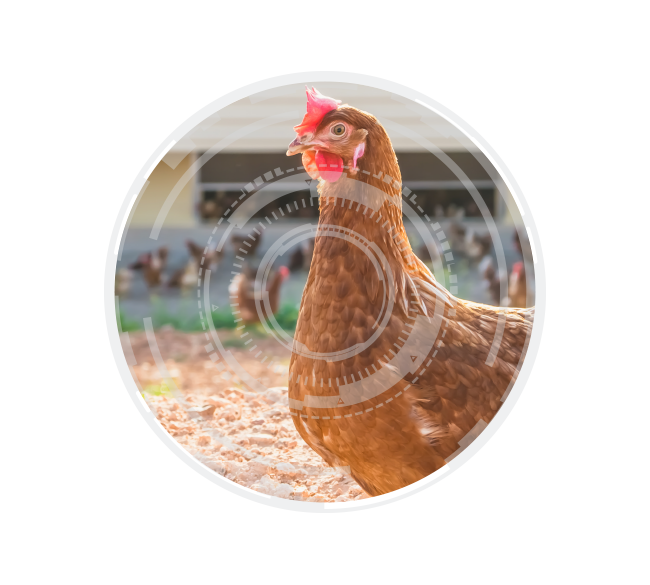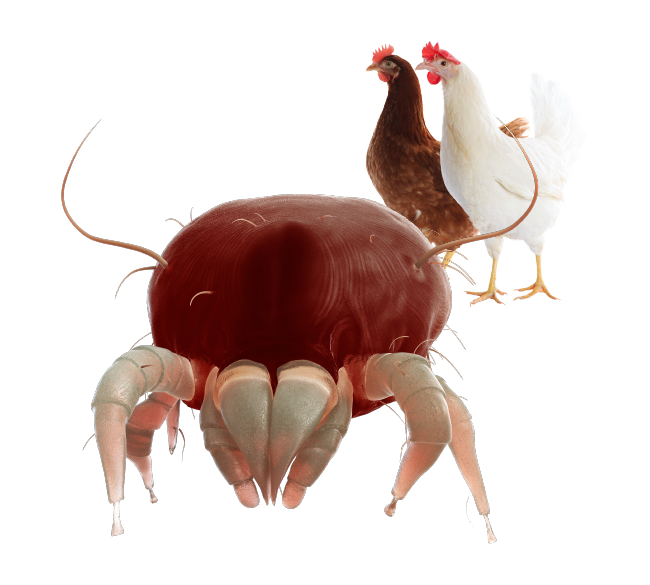Summary
The above review of current recommendations for optimal layer nutrition leads to the following
conclusions and demands for future research:
— The change from conventional cages to barn and free range management requires reliable estimates of additional energy needs for exercise, degree of feather cover and deviations from thermo-neutral temperature.
— Differences between hens (between and within strains) in their ability to adjust daily feed intake to variable temperature and energy content of feed should be analyzed with suitably structured data.
— Recommendations for amino acid contents in layer rations and daily intake should be developed for prececal (ileal) digestible AA. This requires analysis of digestibility of components under standardized conditions (KLUTH and RODEHUTSCORD, 2009) and derivation of recommendations on the same basis.
— The efforts to develop a new system to assess the availability of phosphorus should be intensified to improve the utilization of this limited resource and reduce waste in emissions.
— The recommendations for trace elements should be verified with focus on bio-availability from various sources, especially chelated compounds.
— Research to determine the optimal supply of vitamins, especially fat soluble vitamins, should include not only commercial hybrid layers, but also parent stock.
— The change from conventional cages to barn and free range management requires reliable estimates of additional energy needs for exercise, degree of feather cover and deviations from thermo-neutral temperature.
— Differences between hens (between and within strains) in their ability to adjust daily feed intake to variable temperature and energy content of feed should be analyzed with suitably structured data.
— Recommendations for amino acid contents in layer rations and daily intake should be developed for prececal (ileal) digestible AA. This requires analysis of digestibility of components under standardized conditions (KLUTH and RODEHUTSCORD, 2009) and derivation of recommendations on the same basis.
— The efforts to develop a new system to assess the availability of phosphorus should be intensified to improve the utilization of this limited resource and reduce waste in emissions.
— The recommendations for trace elements should be verified with focus on bio-availability from various sources, especially chelated compounds.
— Research to determine the optimal supply of vitamins, especially fat soluble vitamins, should include not only commercial hybrid layers, but also parent stock.

Introduction
The first monograph with recommended energy and nutrient requirements (as percentage or units per kg of diet, amounts required per hen daily) of poultry was published in 1944 by the US National Research Council (NRC). These standards were based on the substantial knowledge available at that time in North America on energy and nutrient requirements of laying hens and other poultry as well as contents (energy, nutrients) of feedstuffs used in poultry diets. The tables were updated in subsequent editions (9th edition published in 1994).Europe followed in 1963, with recommendations for energy and nutrient requirements, published by the Agricultural Research Council (ARC) in the UK. In Germany, the Committee for the development of energy and nutrient standards published the first recommendations for energy and nutrient requirements of layers and broilers and for the concentration of energy and nutrients in rations in 1999, for fattening turkeys in 2004 (GfE).
As shown in table 1, several national research groups worked on this subject and published recommendations, and H. VOGT of the Poultry Research Center in Celle coordinated a project of the WPSA Working Group Poultry Nutrition to work out recommendations for Europe. Recommendations for minerals were published in 1981 and followed for macro-elements for growing and adult poultry in 1984 and 1985; recommendations for trace elements and vitamins were planned, but never published. The American monographs on poultry nutrition cover energy and nutrient needs extensively. In his book „The Scientific Feeding of Chickens“, TITUS (1st edition 1941, 4th edition 1961) already lists relevant information on energy and nutrient content in poultry feed. SCOTT, NESHEIM and YOUNG treated energy and nutrient requirements in their book „Nutrition of the Chicken“ (1st edition 1969) in great scientific detail and depth. This tradition is continued in the 4th edition of „Scott`s Nutrition of the Chicken“, edited by LEESON and SUMMERS (2001). H. VOGT (1987) followed the factorial approach and contributed an extensive chapter on energy and nutrient requirements of poultry in „Geflügel“ (SCHOLTYSSEK).
Recommended energy and nutrient contents in whole rations and concentrates have also been published by companies specialized in feed additives (e.g. Evonik), by trade associations (e.g. AWT for amino acids and vitamins) and by primary poultry breeding companies (e.g. Lohmann Tierzucht). The following discussion refers primarily to recommendations for laying hens published by scientific organisations (table 1) or authors of books. Recommendations are based on the daily nutritional needs of laying hens depending on age and current production, expressed in terms of contents in complete rations.
Scientific recommendations and safety margins
The requirements determined under experimental conditions are not always sufficient in practice, for various reasons listed in table 2, and the rations should be supplemented to provide necessary safety margins. How much to supplement cannot be derived from experimental results and needs experience and judgment on the part of the producer; excessive levels of nutrients may also be detrimental.Table 1. Recommendations published by scientific organisations
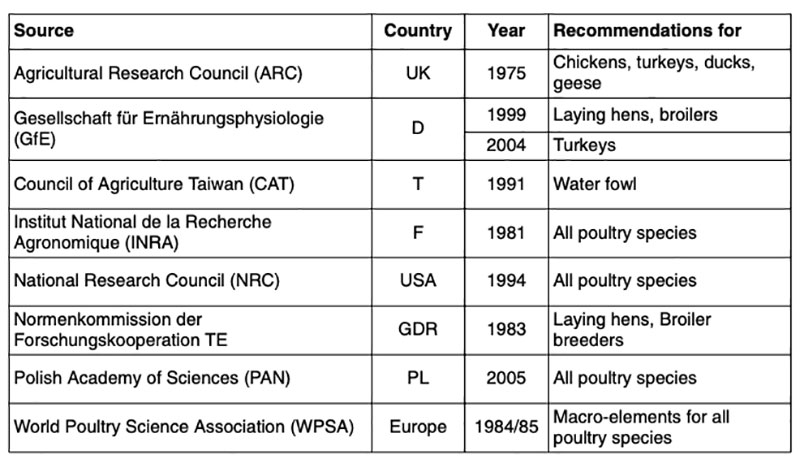
Table 2. Reasons for recommended additions/allowances to scientifically determined
requirements (energy, nutrients)

Energy requirement and supply
Energy in poultry feed is expressed world-wide (in Germany since the early 1960s) in terms of apparent metabolisable energy, N-corrected (AMEN). Contents of components and complete diets and recommendations for daily intake are commonly expressed in kJ or MJ (occasionally still in kcal). The energy requirement for laying hens in table 3 has been derived by the factorial method described by GfE (1999). The daily energy needs are the sum of requirements for maintenance and for production. The maintenance requirements are primarily determined by metabolic body mass of the hens. Additional factors are activity (more in barn and free range systems than in cages), ambient temperature, condition of feather cover and genotype.The energy requirements for production are primarily determined daily egg mass output, body mass increase between sexual maturity and mature weight and regrowth of feathers. Table 3 shows the suggested energy demand from several published sources for layers with 1.8 and 2.2 kg body mass, producing 55 or 60 g egg mass per day.
All recommendations for laying hens in conventional cages, with the exception of the 1975 ARC figures, are in close agreement. The latter assume higher energy requirements for maintenance, which accounts for 60 % of total energy needs, while only 40 % are used for production.
The GfE recommendations assume 10 % and 15 % more maintenance energy for activity in barn egg and free range systems compared to cages, but so far insufficient experimental results are available to confirm these rough figures. Additional energy will also be needed for dissipation of body heat in case the house temperature exceeds the thermo-neutral optimum. This would be a frequent problem in subtropical and tropical regions, occasionally also during hot summers in moderate climate zones like central Europe and therefore justifies more research.
Additional energy is also needed if the ambient temperature drops below 15 °C. The GfE (1999) recommendations assume 7 kJ/kg W0,75/d more energy for each °C lower temperature. Loss of feathers has to be compensated with more energy to maintain body temperature, especially in case of induced molting. More experimental results quantifying the actual effect of different degrees of feather loss on energy demand are needed.
Table 3. Recommendations for energy requirements of laying hens at peak production under
conditions of thermo-neutral temperature
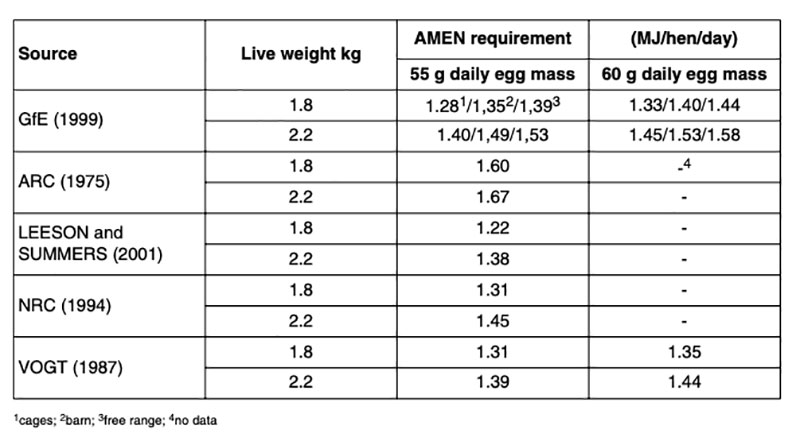
The recommendations for optimal energy supply (in AMEN/kg diet) are in reasonable agreement (table 4), with the exception of the ARC (1975) experts, who assumed that laying hens can adjust their daily energy intake by increased feed consumption, provided a minimum of 9.6 MJ/kg feed is assured. Although we agree that hens tend to adjust their feed intake to some degree on the basis of energy content, our own results suggest that 9.6 MJ/kg would be too low for today’s highly efficient layers, who are unlikely to increase their feed intake accordingly.
Table 4. Recommendations for energy content of laying hen diets
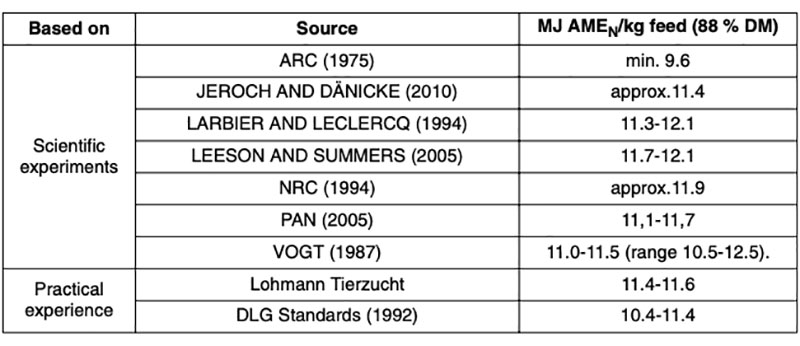
Adequate energy supply at high ambient temperatures is always a challenge. With increasing temperature, laying hens reduce their daily feed intake and thereby energy and nutrient intake. In older literature it has been suggested to increase energy density at high temperature to compensate for reduced feed intake. At high temperature, when the daily intake is already low, the hens will reduce their intake less in response to increased energy concentration of feed, with the net effect of increased energy intake, as shown in table 5.
The energy concentration of layer diets can be increased by added fat or oil, which has the additional advantage of improved feed structure and reduced metabolic heat production compared to other feed components. While these relationships are commonly understood in commercial feed formulation today, it would be highly desirable to verify the rather old results with modern hybrid layers to quantify the effects and fine-tune recommendations.
Table 5. Effect of feed energy concentration (AMEN) on daily intake of feed and metabolisable
energy at different temperatures1
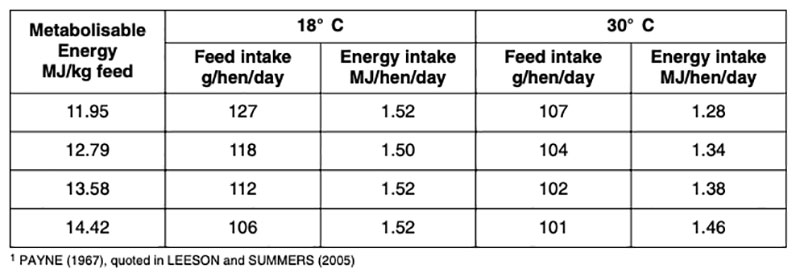
Crude protein/ amino acid requirements and supply
The protein and amino acid (AA) requirements for laying hens have been the subject of extensive research in the past, based on the factorial method (GfE, 1999). Other estimates of requirements were derived from metabolic studies and performance trials. As shown in table 6, the AA requirements published by GfE (1999) are in the range of other recommendations. With the exception of tryptophan, the NRC (1994) listed the lowest levels for all AA, while AWT (2000) advocates a higher lysine level than other sources. All figures refer to total amino acids.Table 6. Daily requirements for crude protein and amino acids for a laying hen with 1.8 kg
body mass and 60 g daily egg production
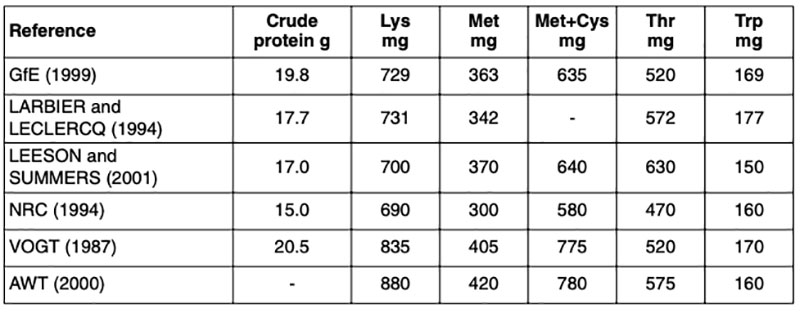
As an alternative to the factorial derivation of AA requirements, the calculations can also be based on the concept of ideal proteins, as described by GRAMZOW (2001) and others. With this approach, only the requirement for a reference amino acid, usually lysine has to be determined, either by the factorial method, in balance trials or in dose-effect feeding trials. Table 7 gives a summary of ideal AA profiles published by different authors; their effects were discussed recently by BREGENDAHL, (2009). From the known relationship to other AA, the requirements for all other AA can then be derived. Current recommendations of Lohmann Tierzucht follow LEMME (2009). Additional research is needed to generate input data in terms of standardized ileal digestibility (KLUTH and RODEHUTSCORD, 2009) to define the ideal AA profile and fine-tune the recommendations for modern laying hens.
Table 7. Ideal amino acid profiles derived by different authors for laying hens
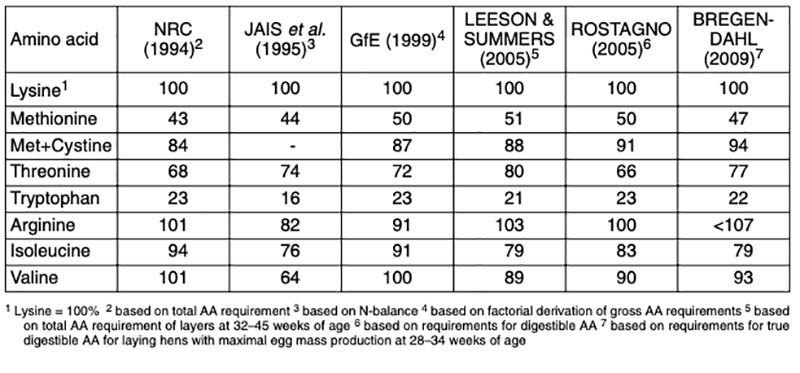
When comparing the recommended CP and total AA levels between different sources in table 8, the corresponding feed energy content needs to be kept in mind. The GfE recommendations are based on the results of factorial method and were first calculated for 1 MJ AMEN and then for common energy levels. The levels listed by GfE and NRC (1994) are lower than those from other sources and take no safety limit into account.
For application in practice, about 10 % higher levels should be used (e.g. 6.9 g instead of 6.3 g lysine/kg feed with 11.4 MJ AMEN/kg). Results of a recent trial (HALLE et al., 2005) comparing recommended GfE levels with 15 % higher or lower AA levels are shown in table 9. In this trial, higher concentrations did not improve performance, but lower levels of lysine and methionine had significant negative effects on egg output and feed conversion ratio. In the past, recommendations were usually expressed in terms of total amino acids. More recently, AWT (2000) and Evonik-Degussa GmbH (LEMME, 2009) suggested to focus on true digestible AA for layers, which differs from the concept of standardized prececal (ileal) digestible amino acids (KLUTH and RODEHUTSCORD, 2009).
Table 8. Recommendations for crude protein and amino acid contents of complete layer
feed (88 % DM) during early laying month and peak production
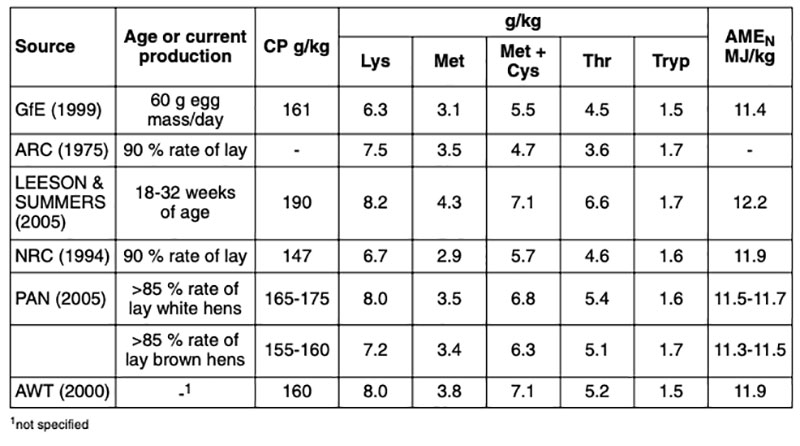
Macro-elements requirement and supply
The requirements for macro-elements have been determined with the factorial method, like for energy, crude protein and essential amino acids (GfE, 1999). To calculate adequate phosphorus requirement is difficult, because the digestibility of phytate-P from plants and phytase concentration in plants vary considerably.The requirement recommendations for this element are currently expressed in terms of available P (aP) or non-phytate-P (NPP), but this is not satisfactory (GfE 1999 und 2004); a new system is suggested, based on “usable” phosphorus.
Table 10 shows requirements derived by WPSA (1985) and GfE (1999), based on factorial calculations. Differences in the Ca recommendations result from the assumed utilization: GfE assumed 55 % (at peak production), WPSA 50 % (on average), and modern phase feeding assumes only 40 % toward the end of the laying period.
Table 9. Effects of reduced vs. increased lysine or/and methionine levels compared to GfE
(1999) standards with phase feeding of commercial laying hens (Lohmann LSLClassic)1,2
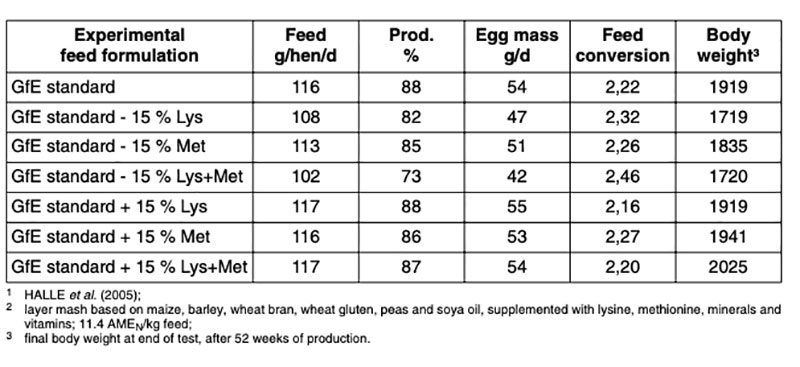
Table 10. Requirement of macro-elements (g/hen/day) for different body weight and egg mass
production
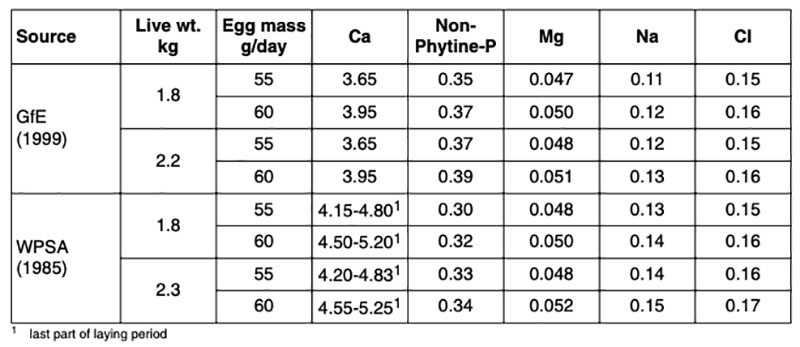
The recommendations for the contents of macro-elements in complete layer rations summarized in table 11 are based on the results of factorial experiments or trials focused on the response to increasing dosage of given elements. LEESON and SUMMERS (2005) present recommendations for specified hen age, energy content of feed and daily feed intake. The rather high Ca levels quoted by these authors are partly explained by the high energy level of typical feed formulation in the USA, with corresponding lower feed intake.
The NRC (1994) recommendations vary with feed intake, while PAN (2005) take strain of layer and rate of lay into account in addition to feed intake. In agreement with WPSA (1984) recommendations, both sources recommend increased Ca levels as the hens get older.
Table 11. Recommendations for macro-element contents in layer mash (88 % TS) during early
laying months and peak production

The recommended levels for phosphorus appear excessive and are probably due to the uncertainties discussed above. In a recent trial, KOZLOWSKI and JEROCH (2011) demonstrated that much lower levels of non-phytate-P are adequate, provided the feed contains sufficient phytase (table 12). As an added benefit, the hens would excrete less P.
Table 12. Effect of added phytase on egg production, feed efficiency and shell strength
(Lohmann Brown layers, 21-40 weeks of age) 1, 2

Supply with trace elements
The most important trace elements in layer rations are iron, copper, zink, manganese, iodine and selenium. No recommendations based on the factorial method have been published (reasons discussed by GfE, 1999). The recommended levels are exclusively derived from dose-effect feeding trials and show considerable variation (table 13).With the exception of Fe, the NRC values are probably too low under commercial conditions. The GfE (1999) advocates levels of trace elements „which are optimal for the most productive and most efficient individual layers under commercial conditions”. Some authors recommend higher levels in breeder rations than in layer feed, but GfE considers the recommendations adequate for parent stock as well. The scientific support for such claims is, however, limited and perhaps outdated
Table 13. Recommended levels of trace elements in layer rations (mg/kg feed with 88 % DM
and normal AMEN)
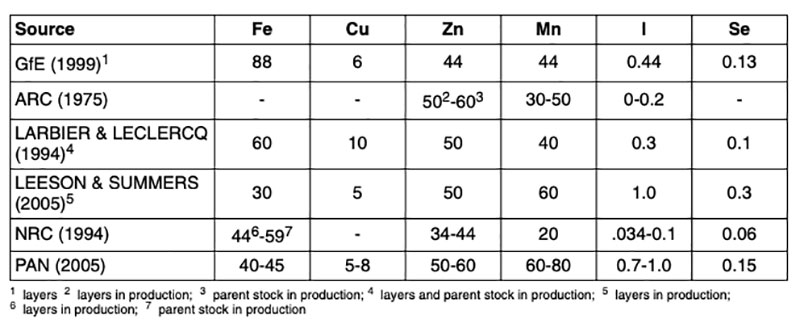
Additions of trace elements in feed supplements follow recommendations. However, in designing feed supplements, the trace elements contained in components are often ignored, and this may lead to overconsumption and excessive levels in excreta. Questions regarding the use of organic vs. inorganic compounds of trace elements have recently been discussed e.g. by SCHENKEL (2008). It has been demonstrated that some organic compounds of trace elements (especially Se) have a higher bio-availability than inorganic compounds in poultry as well. This means that lower levels in daily intake can reduce levels in excreta without sacrificing productivity and health. Experimental results for organic compounds of Zn-, Mn- and Cu are still inconclusive (review of literature, ref. SIMON, 2011). Additional experiments, especially with laying hens, are necessary in this area. Feed formulations for the production of designer eggs generally contain much higher concentrations of specific trace elements than recommended for normal functioning and egg production.
Supply with vitamins
Balanced poultry feed requires feed additives for most vitamins. A factorial determination of requirements is impossible for the same reason as for trace elements: lack of detailed information about basic data. The GfE and NRC recommendations shown in table 14 are based on dose-response feeding experiments. In some experiments, the effects of different dosage were not only related to egg production, but also to contents in liver and egg yolk as well as biochemical parameters.It should be pointed out that the recommendations in table 14 are based on feeding experiments many years ago, when the rate of production was much lower and feed conversion ratio (FCR) higher (table 15). As demonstrated in table 16, the vitamin A intake per unit egg mass is reduced by about one third due to higher production, if the feed formulation follows the NRC recommendations (2930 IE/kg feed). According to LEESON (2007), the NRC figures are not adequate for today’s highly efficient layers. The GfE recommendations should be updated, based on recent experimental evidence and with necessary safety margins.
Other authors recommend much higher vitamin levels than NRC (1994) and GfE (1999), especially for fat soluble vitamins. Relationships between increased vitamin intake and benefits of “designer eggs” for human health or benefits for the immune system of laying hens will not be covered here.
In feed formulation, vitamins contained in components are usually ignored. This is justified for vitamins A, D3 und B12 because today’s commercial rations contain only plant components, which may contain only low concentrations of ß-carotine. Other vitamins are contained in sufficient, sometimes even excessive, concentration in feed components. The recommendations of WHITEHEAD (1998) take the contents of B vitamins in components into account.
Table 14. Recommendations for vitamin contents and additives per kg all mash layer feed
with 88 % DM and normal AMEN content
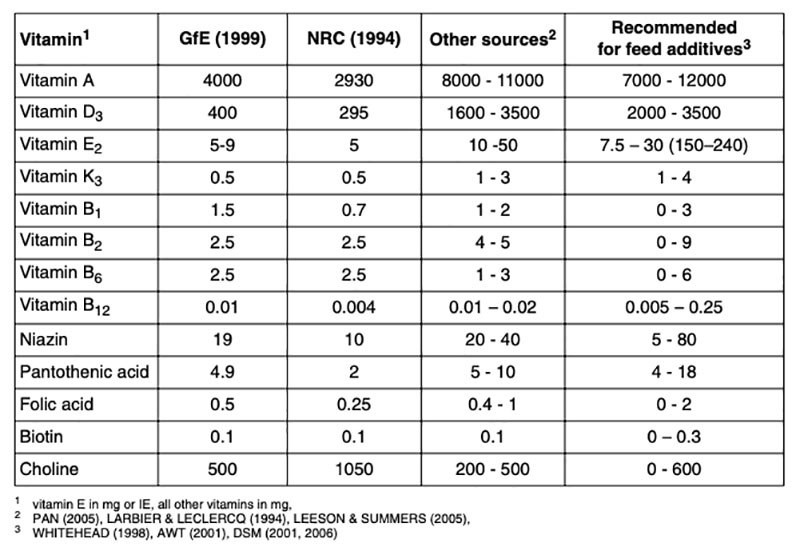
Table 15. Development of egg production and feed efficiency in German random sample tests
(conventional cages)
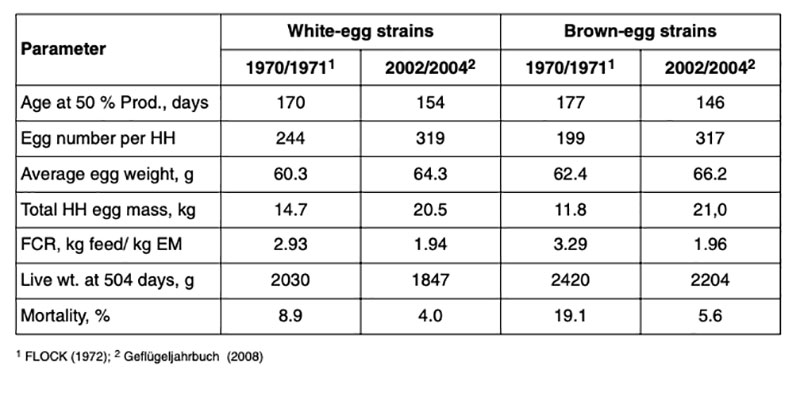
Table 16. Comparison of vitamin A intake of laying hens if the same NRC (1994) standards
were used in 1970/71 and 2002/04

References
Arbeitsgemeinschaft für Wirkstoffe in der Tierernährung (AWT) (2000) Aminosäuren in der Tierernährung, Agrimedia Verlag, Bergen/Dumme, 59 pp.Arbeitsgemeinschaft für Wirkstoffe in der Tierernährung (AWT) (2001) Vitamine in der Tierernährung, Agrimedia Verlag, Bergen/Dumme, 78 pp.
Agricultural Research Council (ARC) (1975) The Nutrient Requirements of Farm Livestock, No. 1 Poultry, 153 pp.
Ausschuß für Bedarfsnormen der Gesellschaft für Ernährungsphysiologie (1999) Empfehlungen zur Energie- und Nährstoffversorgung der Legehennen und Broiler, DLG-Verlag, Frankfurt am Main, 145 pp.
Ausschuß für Bedarfsnormen der Gesellschaft für Ernährungsphysiologie (2004) Empfehlungen zur Energie und Nährstoffversorgung der Mastputen. Proceedings of the Society of Nutrition Physiology 13, 199-233.
Bregendahl K. (2009) Das ideale Aminosäurenprofil für Legehennen. AminoNews. 13 (01), 7-12.
Deutsche Landwirtschafts-Gesellschaft (1992): DLG-Mischfutterstandards, Teil 2 für Rinder, Schafe, Pferde, Kaninchen, Geflügel und Fische.
DSM (2006) Fortification Guidelines, DSM Nutrition Products Inc., Parsippany, NJ, USA.
Gramzow St. (2001) Untersuchungen zum idealen Protein schwerer männlicher Mastputen. Shaker Verlag Aachen, 152 pp.
Halle Ingrid, Dänicke S., Rauch H.-W. (2005) Untersuchungen zur Aminosäurenversorgung von Legehybriden. Archiv für Geflügelkunde 69, 167-174.
Jeroch H., Hoffmann L. (1983) Energie-, Protein- und Aminosäure-bedarfsnormen für Hennen der Legerichtung (Legehybriden) und der Mastrichtung (Broilerhennen). Institut für Geflügelwirtschaft Merbitz, Berichte zur Geflügelproduktion 14, 4-20.
Kozlowski, K.., Jeroch, H. (2011): Efficacy of different levels of Escherichia coli phytase in hens fed maize-soyabean meal based diets with a decreased non-phytate phosphorus content. Journal of Animal and Feed Science 20, 224-235.
Kluth H., Rodehutscord M. (2009) Standardisierte Futterbewertung auf der Basis der Aminosäurenverdaulichkeit beim Geflügel. Übersichten zur Tierernährung 37, 1-26.
Larbier M., Leclercq M. (1994) Nutrition and Feeding of Poultry. Nottingham University Press, Loughborough /GB, 305 pp.
Leeson S. (2007) Vitamin requirement: is there basis for re-evaluating dietary specifications? World`s Poultry Science Journal 63, 255-266.
Leeson S., Summers J.D. (2001) Scott`s Nutrition of the Chicken, 4th ed., University Books, Guelph, Ontario, Canada, 591 pp.
Leeson S., Summers J.D. (2005) Commercial Poultry Nutrition, 3rd ed., Nottingham University Press, UK, 398 pp.
Lemme A. (2009) Amino acid recommendations for laying hens. Lohmann Information 44, 21-32.
National Research Council (NRC) (1994) Nutrient requirements of poultry, 9th revised ed., National Academie Press, Washington, D. C., 155 pp.
Polnische Akademie der Wissenschaften (PAN) (2005) Nährstoffbedarf des Geflügels-Nährwert der Futtermittel und Fütterungsempfehlungen, 4th ed., Kielanowski-Institut für Tierphysiologie und Ernährung, Jablonna/Warszawa, 135 pp (in Polish).
Schenkel H. (2008) Verfügbarkeit und Verwertbarkeit von Spurenelementen aus unterschiedlichen Supplementen. In: Eder K. (Hrsg.) 10. Tagung Schweine- und Geflügelernährung, Halle (Saale), pp. 83-86.
Vogt H. (1957) Fütterung des Geflügels. In: Scholtyssek S. (Hrsg.) Geflügel, Verlag Eugen Ulmer, Stuttgart, pp 216-311. Simon Annette (2011) Unpublished manuscript.
Whitehead C.C. (1998) Vitamin interactions and requirements in poultry. In: 7th International Symposium on Animal Nutrition, Kaposvar, Hungary, pp. 3-31.
WPSA (World`s Poultry Science Association) (1981) Mineral requirements for poultry/recommendations in european countries. World`s Poultry Science Journal 37, 127-138.
WPSA (World`s Poultry Science Association) (1984) Mineral requirements and recommendations for adult birds. World`s Poultry Science Journal 40, 183-187.
WPSA (World`s Poultry Science Association) (1985) Mineral requirements and recommendations for growing birds. World`s Poultry Science Journal 41, 252-258.
Zusammenfassung
Versorgungsempfehlungen für Energie und Nährstoffe bei Legehennen kritisch hinterfragtDer vorliegende Übersichtsartikel analysiert kritisch Versorgungsempfehlungen (Bedarf, Futtergehalte) für Umsetzbare Energie und Nährstoffe (Rohprotein, Aminosäuren, Mengen- und Spurenelemente, Vitamine) von Legehennen. Dabei werden vor allem die Empfehlungen der Gesellschaft für Ernährungsphysiologie, internationaler wissenschaftlicher Gremien (u.a. National Research Council, Polnische Akademie der Wissenschaften, World Poultry Science Association), Monografien zur Geflügelernährung (u.a. Leeson und Summers, 2005) sowie ausgewählte neuere Veröffentlichungen zur Thematik herangezogen. Es werden Schwachstellen aufgezeigt und daraus Hinweise für wissenschaftliche Aufgabenstellungen abgeleitet. Hierzu zählen insbesondere: Objektivere Einschätzung des zusätzlichen Energiebedarfs für Bewegungsaktivitäten, unterschiedliche Befiederung und für Umgebungstemperaturen unterhalb als auch oberhalb des thermoneutralen Bereiches, Futterverzehrsverhalten in Abhängigkeit vom Energiegehalt der Futtermischung in verschiedenen Bereichen der Umgebungstemperatur, AS-Versorgungsempfehlungen auf der Basis der standardisierten praeceacal verdaulichen Aminosäuren, neues Phosphorbewertungssystem, Bioverfügbarkeit der Spurenlemente aus organischen Verbindungen, Versorgungsempfehlungen mit fettlöslichen Vitaminen für Hochleistungshennen und begründete Sicherheitszuschläge.



